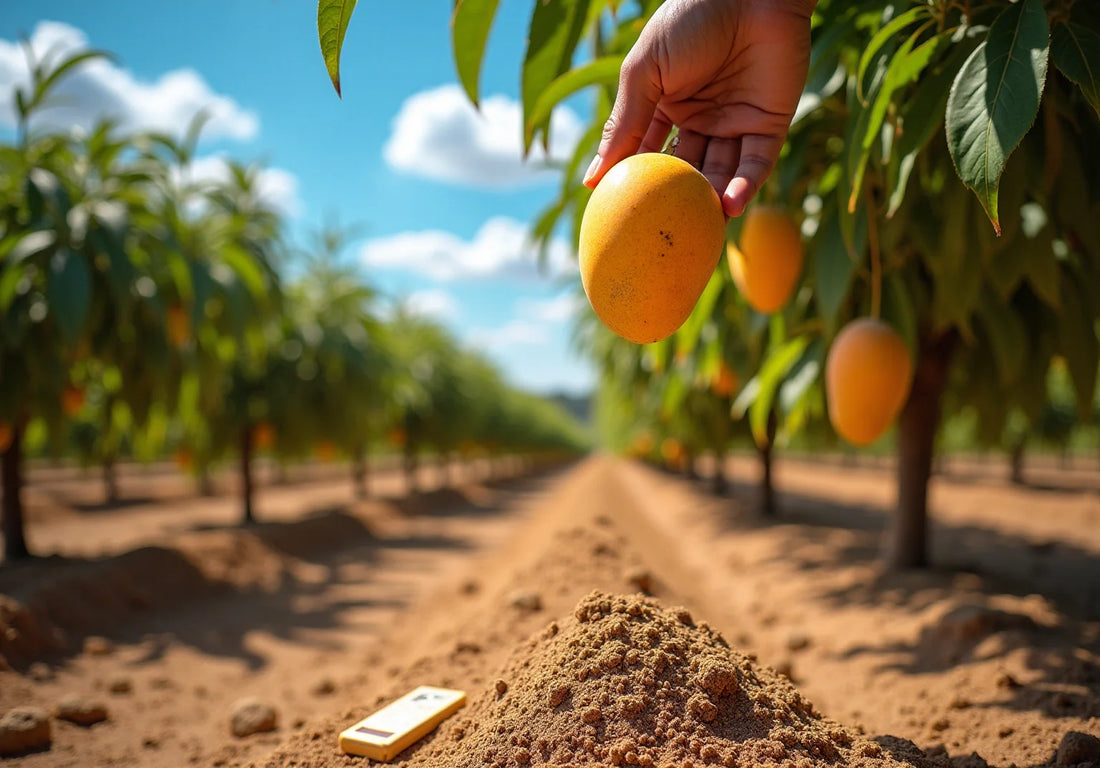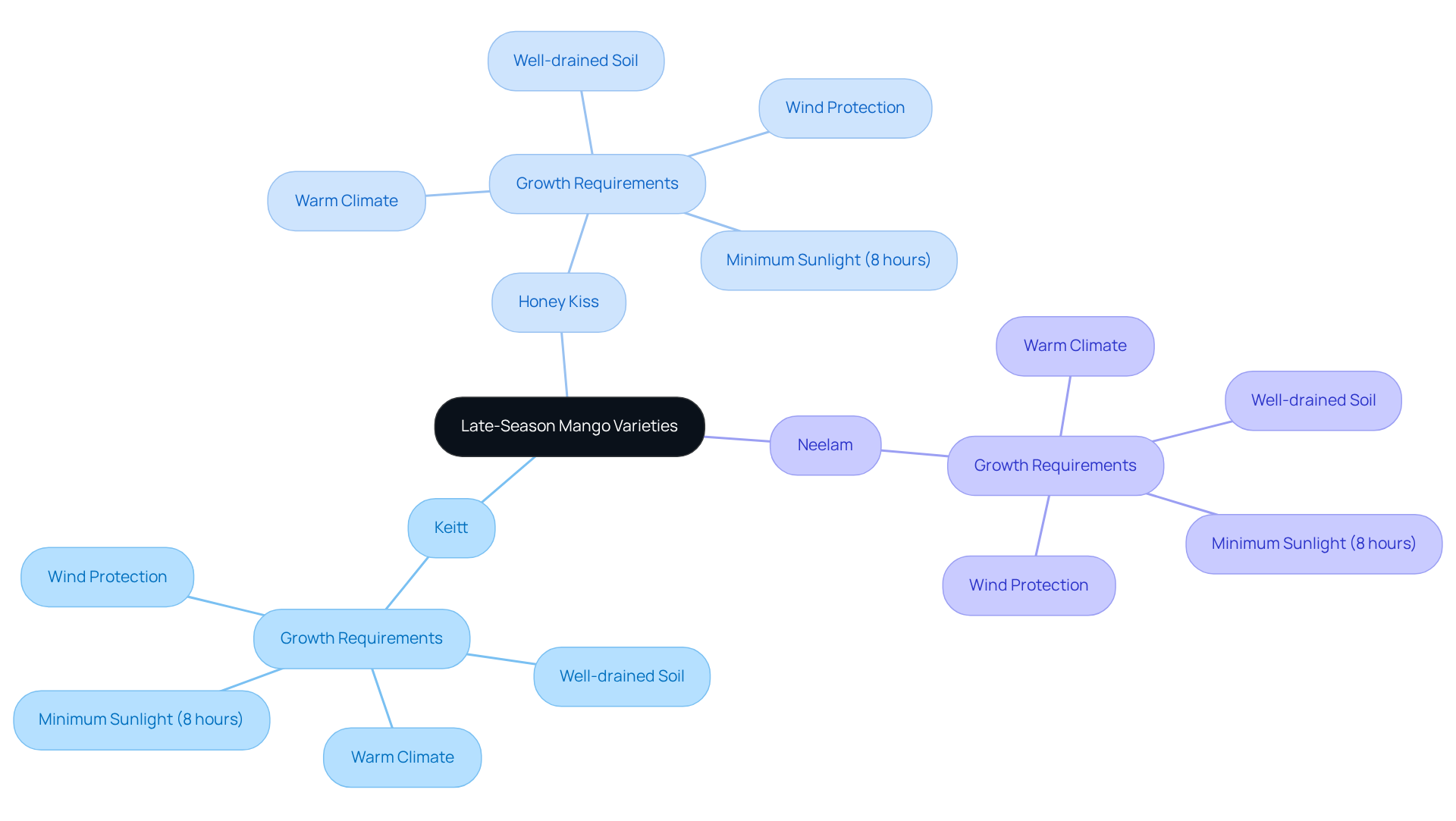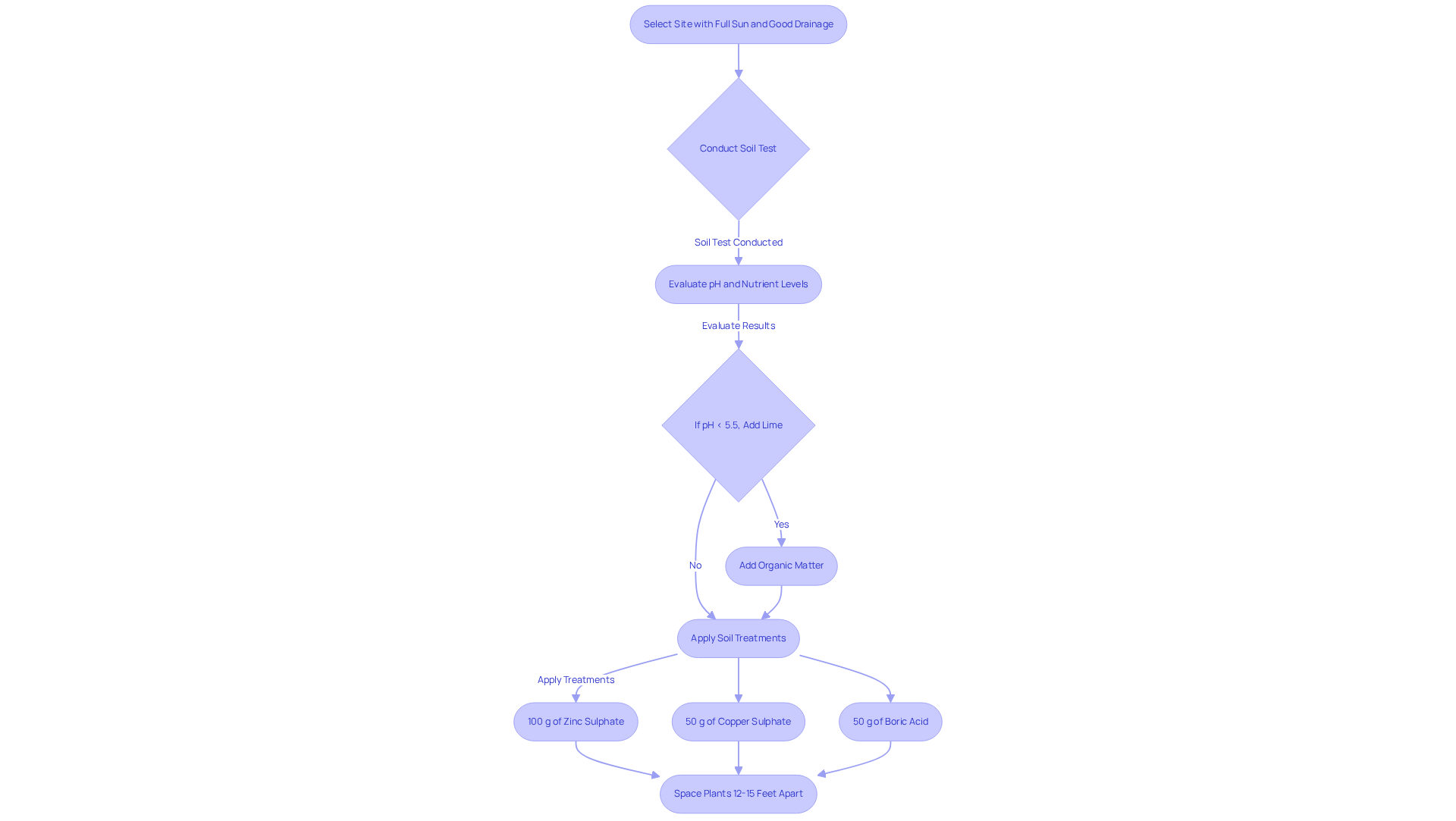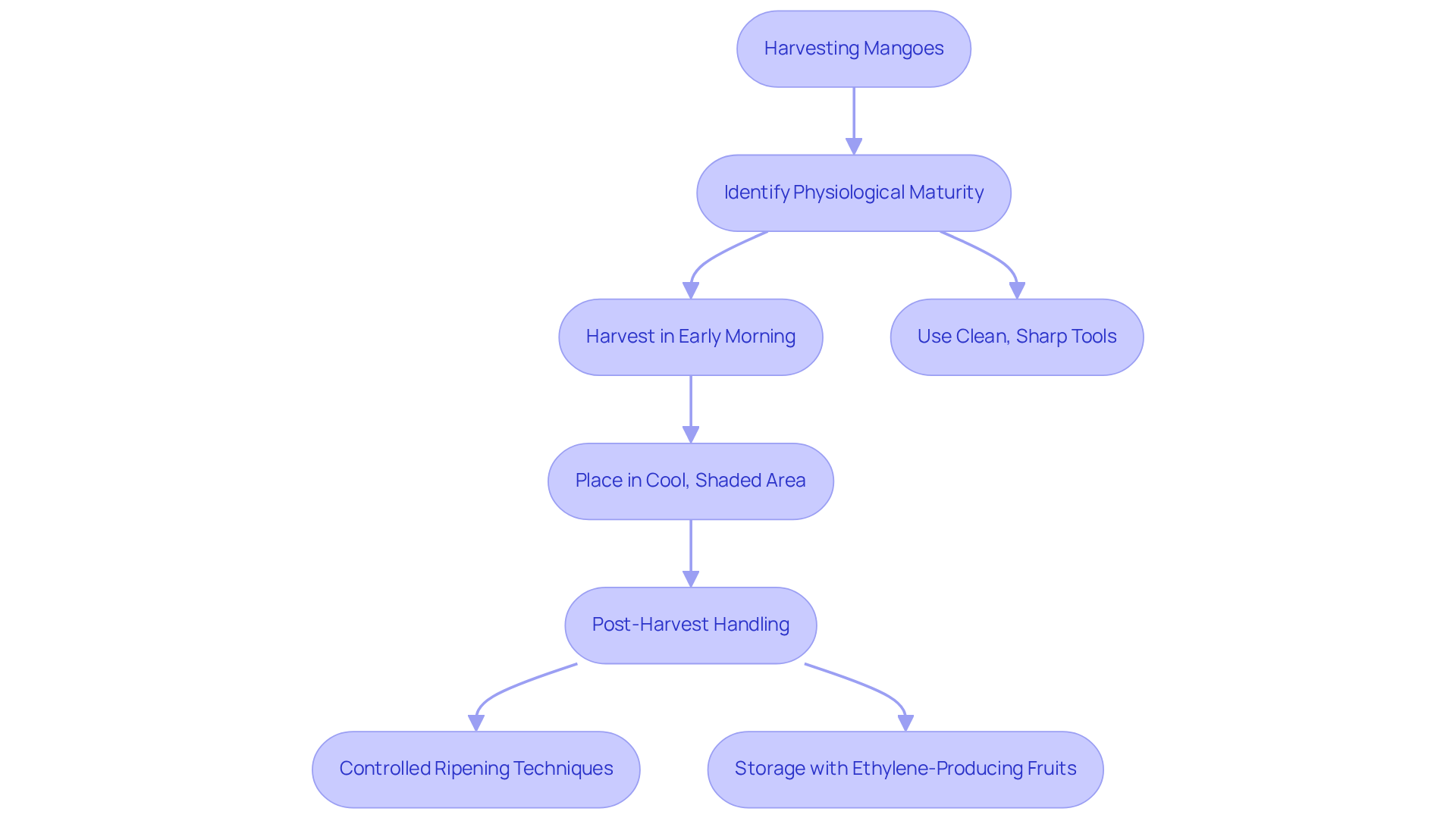
Late Season Mango Varieties: Growth & Care Guide
Share
Late season mango varieties are not merely an extension of the harvest season; they present a distinctive opportunity for gardeners to optimize their yields and savor the rich flavors of fruits like 'Keitt' and 'Honey Kiss.'
By comprehending the specific requirements of these varieties—spanning optimal soil conditions to effective care techniques—gardeners can elevate a simple gardening endeavor into a rewarding venture.
The real challenge, however, lies in mastering the intricacies of cultivating these mangoes, from site selection to post-harvest handling.
What strategies can gardeners implement to ensure their late season mangoes flourish and yield high-quality fruit?
1. Understand Late-Season Mango Varieties and Their Requirements
Late-season mango varieties, such as 'Keitt' and 'Honey Kiss', flourish in warm climates and have specific growth requirements crucial for successful cultivation. These late season mango varieties extend the harvest season, typically yielding fruit later in the year. They thrive in well-drained, sandy loam soil with a pH level ranging from 5.5 to 7.5, which optimizes nutrient absorption. Furthermore, these fruit trees require a minimum of eight hours of sunlight daily and should be shielded from strong winds to encourage healthy growth and fruiting.
The 'Keitt' variety is one of the late season mango varieties, known for its large, sweet fruit that is generally harvested from late August to October. In contrast, 'Honey Kiss' is renowned for its rich flavor and is typically categorized among the late season mango varieties ready for harvest in September. By carefully selecting the appropriate variety based on local climate and soil conditions, gardeners can enhance their yields and enjoy an extended fruit season. This strategic approach not only enriches the gardening experience but also aligns with the increasing consumer demand for this fruit, evidenced by a 26% rise in consumption in 2023 compared to the previous year.

2. Select the Right Site and Optimize Growing Conditions
To effectively grow late season mango varieties, it is essential to select a location that receives full sun and has good drainage. Mango trees thrive in soil with a pH ranging from 5.5 to 7.5, making it crucial to conduct a soil test to evaluate pH and nutrient levels. If the soil is too acidic, adding lime can effectively raise the pH. Additionally, incorporating organic matter, such as compost, not only improves soil structure but also enhances fertility.
Effective soil treatments involve applying:
- 100 g of Zinc sulphate
- 50 g of Copper sulphate
- 50 g of Boric acid
These treatments can significantly improve fruit yield and quality. It is important to ensure that the planting area is free of competing plants, as they can hinder the development of young fruit plants. Furthermore, fruit-bearing plants should be spaced approximately 12 to 15 feet apart to promote proper air circulation.
By optimizing these conditions, gardeners can create a thriving environment for their mango plants, ultimately leading to a fruitful harvest.

3. Implement Effective Care Techniques for Healthy Growth
Mango plants thrive with diligent care, requiring deep and occasional watering to foster robust root development. Allowing the soil to dry between watering sessions is beneficial, as it helps establish a solid foundation for the plant. During the growing season, applying a balanced fertilizer with a higher potassium content—specifically one with a 6-6-6 or 8-3-9 N-P-K ratio—is crucial for promoting flowering and fruiting. Fertilization should be strategically scheduled three times a year:
- In late winter or early spring
- Late spring or early summer
- Late summer after fruit harvest
For young plants, fertilizing every 2-3 months during the first year is vital for cultivating strong roots and healthy growth.
Effective pest management is essential to maintain plant health. Regularly inspect for common pests such as fruit flies and aphids. Implement integrated pest management strategies, which may include the use of traps and organic pesticides, to minimize damage. Additionally, regular pruning is beneficial; it helps maintain the plant's shape and improves air circulation, reducing the risk of fungal diseases. Caution is necessary to avoid over-fertilizing, as this can lead to nutrient imbalances and excessive foliage growth. By adhering to these care techniques, including the practice of organic mulching to boost yield and water efficiency, gardeners can ensure their fruit trees remain healthy and productive.

4. Master Harvesting and Post-Harvest Handling for Quality Fruit
To ensure optimal quality, mangoes must be harvested at physiological maturity, indicated by a subtle color change and a gentle tug that separates the fruit from the stem. Gathering is most effective in the early morning to mitigate heat stress on the produce. It is essential to utilize clean, sharp tools during this process to minimize damage and maintain the integrity of the fruit.
Post-harvest handling is crucial for preserving fruit quality. After harvesting, the fruit should be placed in a cool, shaded area to prevent overheating. For extended storage, controlled ripening techniques can be employed, such as placing the fruit in a ventilated box alongside ethylene-producing fruits like bananas. This method effectively manages ripening and prolongs shelf life. By implementing proper handling and storage techniques, post-harvest losses can be significantly reduced, enhancing the overall quality of mangoes and ensuring a delightful experience for consumers.

Conclusion
Mastering the cultivation of late-season mango varieties is essential for extending the harvest period and enhancing overall yield. By understanding the specific needs of varieties such as 'Keitt', 'Honey Kiss', and 'Neelam', growers can create optimal conditions that support healthy growth and fruitful production. Selecting the right site, ensuring proper soil health, and implementing effective care techniques are critical components in the successful cultivation of these delicious fruits.
Key insights from this article highlight the importance of:
- Providing adequate sunlight
- Well-drained soil
- Diligent watering practices
Additionally, utilizing appropriate fertilization schedules and pest management strategies can significantly improve plant health and fruit quality. Harvesting at the right time and employing proper post-harvest handling techniques further ensures that the mangoes reach consumers in peak condition.
Ultimately, the journey of cultivating late-season mango varieties not only satisfies the increasing consumer demand but also enriches the gardening experience. By applying these best practices, growers can contribute to a thriving mango industry while enjoying the rewards of their labor. Embrace these strategies to cultivate not just mangoes, but a fruitful future in horticulture.
Cultivate Your Own Mango Paradise Today!
Start now with Everglades Farm and enjoy a bountiful harvest of delicious, tropical mangoes.
🛒 Explore Mango Trees collection
🛒 Buy Keitt Mango Tree
🛒 Buy Honey Kiss Mango Tree
Frequently Asked Questions
What are late-season mango varieties?
Late-season mango varieties are types of mangoes that yield fruit later in the year. Examples include 'Keitt', 'Honey Kiss', and 'Neelam'.
What are the growth requirements for late-season mango varieties?
These varieties require warm climates, well-drained sandy loam soil with a pH level of 5.5 to 7.5, a minimum of eight hours of sunlight daily, and protection from strong winds.
When is the harvest time for the 'Keitt' mango variety?
The 'Keitt' mango variety is generally harvested from late August to October.
What is special about the 'Honey Kiss' mango variety?
The 'Honey Kiss' mango is known for its rich flavor and is typically ready for harvest in September.
How can gardeners enhance their yields of late-season mangoes?
Gardeners can enhance their yields by carefully selecting the appropriate mango variety based on local climate and soil conditions.

